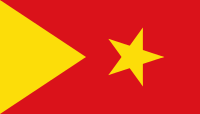Humera
| Setit Humera (ሰቲት ሑመራ) | |
|---|---|
 Setit Humera (ሰቲት ሑመራ) Location within Ethiopia | |
| Coordinates: 14°18′N 36°37′E / 14.300°N 36.617°ECoordinates: 14°18′N 36°37′E / 14.300°N 36.617°E | |
| Country |
|
| Region | Tigray |
| Zone | Mi'irabawi (Western) |
| Population (2007) | |
| • Total | 21,653 |
| Time zone | EAT (UTC+3) |
Humera (also Himora or officially, Setit Humora, Ge'ez ሰቲት ሑመራ Setit hūmerā) is a town and separate woreda in the western Tigray Regional State of Ethiopia, near the borders of Sudan and Eritrea. Located in Western Zone or Mi'irabawi Zone of the Tigray Region, this town has a latitude and a longitude of 14°18′N 36°37′E / 14.300°N 36.617°E. Humera was part of Kafta Humera woreda.
History
Humera is part of the Wolqayt-Tsegede area, which historically has been part of the former province of Semien. During the Ethiopian Civil War, Teranafit and its successor, the Ethiopian Democratic Union (EDU), drew much of their support from the commercial farmers of Humera and Wolqayit, and gained control of Humera in early 1977; Derg forces with tanks and armored cars retook Humera on 10 June, and the officers of the EDU fled to Sudan.[1] The Derg used Humera as a base for military campaigns against the Tigrayan People's Liberation Front (TPLF) until their Third Revolutionary Army was crushed in the Battle of Shire on 19 February 1989; this forced the government to withdraw its garrison at Humera a few days later, and by the end of the month evacuate Tigray entirely. The TPLF then took control of the area, and created a supply line out of reach of the Derg.[2]
In the first few months after the beginning of the Eritrean-Ethiopian War, most of the population fled south to the villages of Ba'eker (11,000), May Kedra (5,000), and Bereket (4,000). These refugees have since returned home.[3]
On 13 March 2008, a bomb exploded on a public bus in Humera, which killed eight persons and wounded at least 27 more. The government arrested the alleged perpetrators, who testified in court they had acted on behalf of dissident groups supported by Eritrea. Their trial was still in process at the end of the year.[4]
Demographics
Based on the 2007 Census conducted by the Central Statistical Agency of Ethiopia (CSA), this town has a total population of 21,653, of whom 11,395 are men and 10,258 women; this is an increase of 14,451 over the 1994 national census. With an area of 153.03 square kilometers, Humera has a population density of 141.50. A total of 49.84% households were counted in this woreda, resulting in an average of 6,360 persons to a household, and 3.40 housing units. The majority of the inhabitants said they practiced Ethiopian Orthodox Christianity, with 93.18% reporting that as their religion, while 6.45% of the population were Muslim.[5]
The 1994 census reported it had a total population of 14,451 of whom 7,649 were men and 6,802 women.
The people speak mainly Tigrinya, although Amharic is also spoken as is Sudanese Arabic.
Economy
The population increases dramatically during the farming season each year, when migrant workers arrive from all over the country. Sesame, tef and sorghum are among the most common crops.
Transport
Humera is served by Humera Airport (ICAO code HAHU, IATA HUE). Although it has not been operational due to an ongoing border dispute, on 26 July 2009 after three years of construction by the Ethiopian Airports Enterprise, the airport was officially reopened. A runway three kilometers long and 45 meters wide was constructed, capable of handling present-day aircraft including Antonov 124s.[6] The airport was opened at the cost of 182 million birr. Ethiopian Airlines serves the airport with destinations to Addis Ababa and Mek'ele. The opening of the airport was aimed at increasing the agricultural sector in the region as well as providing commercial air service in Humera.
References
- ↑ "Hosaina - Hwate" (PDF). Local History in Ethiopia. The Nordic Africa Institute. 2005. p. 7. Retrieved 2011-04-06.
- ↑ Gebru Tareke, The Ethiopian Revolution: War in the Horn of Africa (New Haven: Yale University, 2009), p. 284
- ↑ EUE: Tigray Evacuees, 12/98
- ↑ "2008 Human Rights Reports: Ethiopia", Bureau of Democracy, Human Rights, and Labor, US State Department (accessed 8 July 2009)
- ↑ Census 2007 Tables: Tigray Region Archived 14 November 2010 at the Wayback Machine., Tables 2.1, 2.4, 2.5 and 3.4.
- ↑ "Ethiopia inaugurates international airport at Humera", Ethiopian News Agency 26 July 2009 (accessed 1 November 2009)
